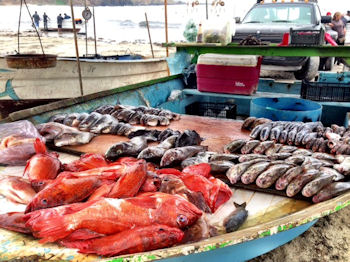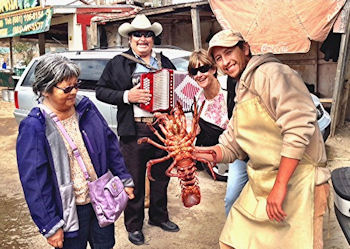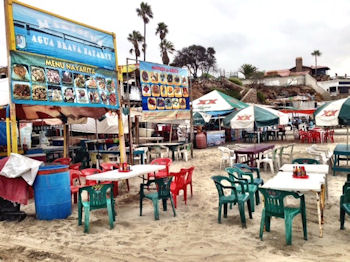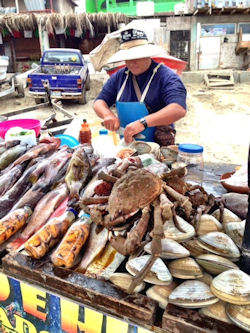 |  |
By Greg Niemann

Fishing villages are scattered throughout Mexico, dotting the coastlines of Baja as well as mainland Mexico. Hardy pescadores (fishermen) set up bases in sheltered little coves and inlets close to where the fish are. Some camps are isolated and very crude, just temporary mesquite shelters in remote areas housing a few men whose catch is periodically sold to traveling seafood vendors. Others are larger, more permanent, and the fishermen sell directly to area restaurants and residents of nearby towns.
Some, especially those close to an expanding tourist population (like Puerto Nuevo), outgrow their original purpose and charm as they morph into something larger and offer fancier restaurants and curio shops that many stateside visitors expect. It’s a challenge to even find a boat at Puerto Nuevo these days, but in the 1970s we used to watch the fishermen return and beach their lobster-laden pangas in the small ravine.
Just a few miles up the road, still in the heart of a tourist area – it’s a different story.
Still a simple fishing village
I was delightfully surprised this past October to visit Puerto Popotla for the first time in many years. The fishing village is about four miles south of Rosarito Beach, behind the aging white arch and the wall on the south side of Fox Baja Studios. Back in 1996, as the studio next door was filming its first motion picture, “Titanic,” I wrote, “What will the future bring to Puerto Popotla? With the area’s mushrooming growth , what is the destiny of this authentic settlement and the fishermen who make their livings here? Who knows? But for now it is the most charming of the accessible fishing villages – if you don’t mind sitting on a beat up old car seat while pigging out on fresh fish tacos.”

Well, instead of an old car seat from over 17 years ago, this time I found a small restaurant with plastic Tecate chairs right on the sand. And the rest of the village? It is virtually the same as 1996, just a little larger and still with the lone dirt road, a few smaller trails and paths, and haphazard clapboard buildings perched precariously on the rocky promontory surrounding the cove.
And there’s all that seafood, being unloaded from the pangas about midday as the fishermen return. Talk about fresh? The beach is full of vendors selling local species of fish: grouper, snapper, all types of bass, cod, corbina, halibut, yellowtail, and more – along with fresh lobsters, crabs, clams, mussels, and oysters. If it comes from the ocean, they’ve got it. And you can buy straight from the boat, or any of the numerous stalls on the beach or on the road.
I had watched the fishing village grow with trepidation. It was kind of my secret place in the early 1990s. I occasionally arranged for an inexpensive fishing day with a couple of the local pangeros who would take me out to work the kelp beds alongside them. Loaded with mostly bottom fish, we’d return, round the point and ride the swell into the beach. It was fun and productive, and I’m sure even today if you ask around somebody will be happy to take you out. Some fishermen also make the one hour run out to the Islas Los Coronados for pelagic species.
I noticed more restaurants and, as mentioned, found a few right on the sand next to the boats. Others on the rocky promontory are still rustic, and you still might find an old car seat for seating and perhaps a large wooden wire spool for a table. Many of the floors are dirt or sand. Many are open-sided with tremendous views. You can watch pelicans diving into the ocean to feed and waves crashing on the rocks all the way south to Calafia on the point. The Calafia high rises about a kilometer to the south seem incongruous and far removed from such a rustic location.
There are still about two dozen restaurants, from fish taco stands to a couple of sit-down tiled floor restaurants. There’s even one designed like the bow of the Titanic, a tribute to the famous movie made next door. There’s also Mariscos Miramar, Mariscos Juquila, Brisa del Mar, Pelicanos, Mariscos Rincon, and the one I enjoyed, Agua Brava Nayarit.

A meal on the sand
There are several small places on the sand and I selected the Agua Brava at random. It is run by Manuel Valdez and his wife Legui, who both hail from the mainland state of Nayarit, just inland from San Blas. I ordered the Pescado Zarandeado and we first selected the fresh fish, a good sized corbina. While Manuel cleaned it and butterflied it for the grill, Legui made superb accompaniments.
I sat and enjoyed the activity around me, boats being unloaded, fish being carted off, small stands readying their catch, pelicans and sea gulls fighting for fish scraps, locals and a few tourists wandering about looking for fresh seafood to take home, and a couple of trinket vendors.
The fish I was served was so good and hefty it was served on a large tray with the rice and beans on a separate plate. The delectable grilled fish was basted golden brown and topped with onions, peppers, and tomatoes.

I was there midweek, and one reason I hadn’t been there in a while is that the place really comes alive on weekends, especially Sundays. The locals are quite aware of Puerto Popotla and as Mexican families like to enjoy Sundays out, many of them crowd into the village. Their cars are lined up all along the 300 yard long dusty dirt road out to the big arch and beyond, many walking from the highway (old road) in search of fresh mariscos (seafood) to feed their families.
The party atmosphere often prevails on weekends, and there’s plenty of music with amped up loud speakers in some restaurants often overpowering the various strolling mariachis.
Before I left I walked around and saw a few tourists buying fish and some of the biggest lobsters I’d seen in years. A few local women were haggling with a vendor over some very attractive scallops. Other local Mexicans came with ice chests which they filled with several species of fresh fish.
You can only see a corner of the village from the highway and you won’t find big tour busses wending their way down that dirt road. But if you like fresh seafood and a slice of rural Mexico, I’m pleased to report that Puerto Popotla might be for you.
About Greg
Greg Niemann, a long-time Baja writer, is the author of Baja Fever, Baja Legends, Palm Springs Legends, Las Vegas Legends, and Big Brown: The Untold Story of UPS. Visit www.gregniemann.com.

Baja Bound Insurance has been my go-to for Mexico insurance for years. The website is super easy to...

Thank God I had a safe trip but it did have me at peace knowing I was fully covered. The staff were...

I've had Baja Bound insurance for more that ten years now with thousands of miles logged in Baja....